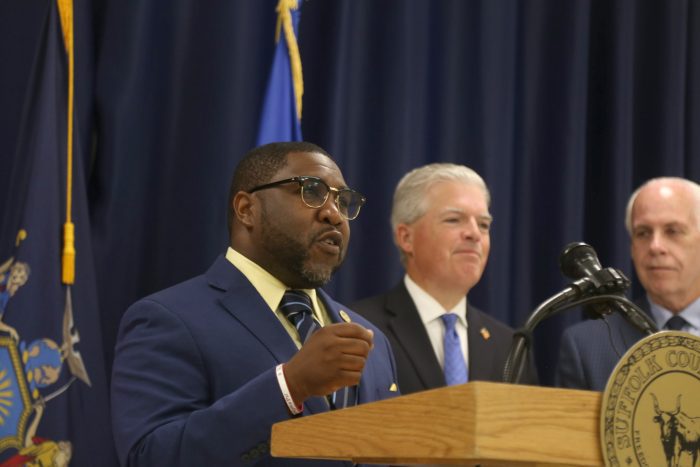After years of disruption to local downtowns caused by the COVID-19 pandemic, Suffolk County is pushing toward economic recovery and revitalization.
A 2021 Rauch Foundation study found that 38% of downtown food and beverage with retail businesses lost a projected 50% or more in revenue in 2020 compared to 2019. The same study outlined the compounding effects of impacts of “auto-oriented development, the emergence of online shopping, and, more recently, the economic shock from COVID” as impacting the viability of Long Island’s downtowns.
County officials gathered at the H. Lee Dennison Building in Hauppauge Tuesday, Sept. 5, announcing the JumpSMART Small Business Downtown Investment Program. Through JumpSMART, the county will set aside $25 million in grants for projects supporting downtown areas’ growth and vibrancy. This funding comes from the $286 million the county received in federal COVID-19 funding through the American Rescue Plan Act.
“Our main streets, our downtowns, are critical to the long-term success of our region,” said Suffolk County Executive Steve Bellone (D). “As we continue to recover from the economic impacts of the pandemic … it is essential that we provide the necessary support” to downtowns.
The county executive said the funding offered through this JumpSMART program would carry out several simultaneous economic development goals, namely expanding housing options and bolstering small business districts.
“Our downtowns are the places where we can create the kind of housing diversity that we know our region needs and that will support, very importantly, small businesses,” he said. “They are also the place where we can create a mix of uses that would reduce car trips and traffic on our roadways.”
The funds earmarked through the program, Bellone said, would also promote various nonprofits and cultural entities throughout the county’s main street business districts: “The JumpSMART program aims to support and invigorate our main street communities by providing to different private and not-for-profit organizations, such as arts and cultural institutions,” Bellone added.
Kevin McCaffrey (R-Lindenhurst), presiding officer of the Suffolk County Legislature and a former trustee of the Village of Lindenhurst, described the downtown revitalization efforts of his village.
“It started with bringing transportation-oriented development into our village,” he said. “We now have that vibrancy down there and young people coming in.”
“We have many downtowns that are in the process of rebuilding, restructuring or revitalizing. This grant program will go a long way toward making sure that we meet all the needs of our downtowns,” McCaffrey added.
Minority Leader Jason Richberg (D-West Babylon) outlined various areas of emphasis for investments in downtowns, such as transit-oriented development, beautification and infrastructure modernization.
“These downtown investments bring people to our communities … and economic development,” he said. “If we keep investing in our small businesses, our economy will grow,” adding, “That will raise our incomes in Suffolk County and bring more people to buy our homes, live in our buildings and use our community.”
In launching this application portal, Bellone said the county government is seeking “big proposals that make a positive impact on our communities.”
A selection panel of administration officials and county legislators will decide on the applications and appropriations.
The application portal is live and will remain open until close of business on Sept. 29. For more information or to apply, visit suffolkcountyny.gov/jumpsmart.







